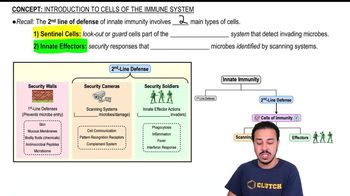Indicate which statements are true. Correct all false statements by changing the underlined words.
__________ Opsonization occurs when a phagocyte’s pseudopods surround a microbe and fuse to form a sac.
 Verified step by step guidance
Verified step by step guidance


Indicate which statements are true. Correct all false statements by changing the underlined words.
__________ Opsonization occurs when a phagocyte’s pseudopods surround a microbe and fuse to form a sac.
Indicate which statements are true. Correct all false statements by changing the underlined words.
__________ Lysosomes fuse with phagosomes to form peroxisomes.
Which of the following lymphocytes predominates in blood?
a. T cells
b. B cells
c. plasma cells
d. memory cells
e. All are about equally prevalent
What do medical personnel administer to counteract various type I hypersensitivities?
a. antihistamine
b. bronchodilator
c. corticosteroid
d. epinephrine
e. all of the above
Indicate whether each statement is true or false. If the statement is false, change the underlined word or phrase to make the statement true.
________ Cyclosporine is released by degranulating mast cells.
Identify the type of hypersensitivity reaction in each photo.
<IMAGE>